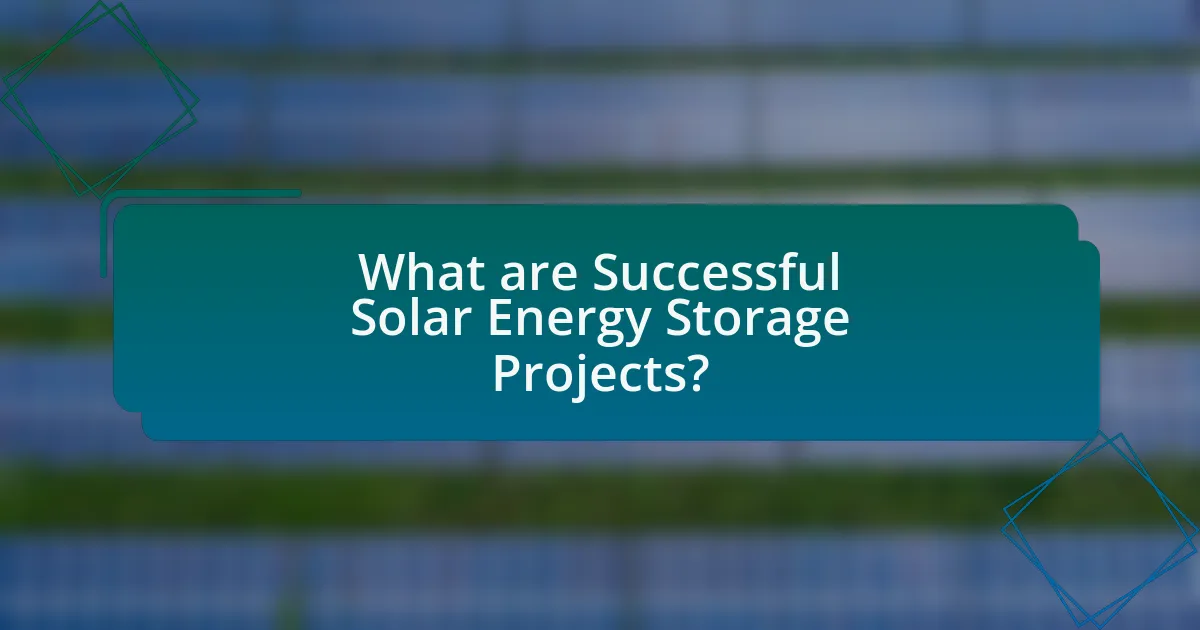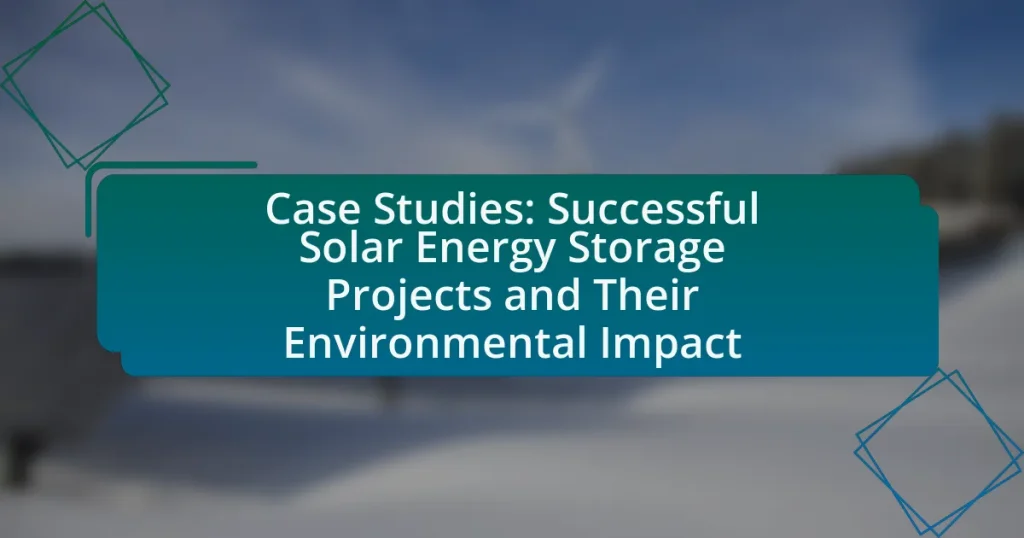The article focuses on successful solar energy storage projects, highlighting notable examples such as the Hornsdale Power Reserve in Australia and the Kauai Island Utility Cooperative in Hawaii. It examines how these projects contribute to renewable energy goals by enhancing energy reliability and efficiency through advanced technologies like lithium-ion and flow batteries. The article also discusses the environmental impacts of solar energy storage, including reductions in greenhouse gas emissions and potential risks to local ecosystems. Additionally, it outlines best practices for project implementation, community engagement strategies, and the economic benefits associated with these initiatives, providing a comprehensive overview of the role of solar energy storage in promoting sustainability.
What are Successful Solar Energy Storage Projects?


Successful solar energy storage projects include the Hornsdale Power Reserve in Australia, which utilizes Tesla’s lithium-ion battery technology to provide grid stability and energy storage, achieving a capacity of 150 MW. This project has demonstrated significant reductions in energy costs and improved reliability for the local grid, showcasing the effectiveness of large-scale battery storage in integrating renewable energy sources. Another notable project is the Kauai Island Utility Cooperative in Hawaii, which employs a combination of solar power and battery storage to provide 100% of its energy needs during peak hours, significantly reducing reliance on fossil fuels. These projects exemplify the potential of solar energy storage to enhance energy resilience and contribute to environmental sustainability.
How do these projects contribute to renewable energy goals?
Successful solar energy storage projects significantly contribute to renewable energy goals by enhancing energy reliability and efficiency. These projects enable the storage of excess solar energy generated during peak sunlight hours, which can then be utilized during periods of low sunlight or high demand. For instance, the deployment of large-scale battery storage systems, such as those implemented in California, allows for the integration of more solar power into the grid, reducing reliance on fossil fuels and lowering greenhouse gas emissions. According to the U.S. Energy Information Administration, renewable energy sources accounted for about 20% of total U.S. electricity generation in 2020, with solar energy playing a crucial role in this transition.
What technologies are commonly used in these projects?
Common technologies used in successful solar energy storage projects include lithium-ion batteries, flow batteries, and advanced energy management systems. Lithium-ion batteries are widely adopted due to their high energy density and efficiency, making them suitable for residential and commercial applications. Flow batteries, such as vanadium redox flow batteries, offer scalability and long-duration energy storage, which is beneficial for grid applications. Advanced energy management systems integrate these storage technologies with solar generation, optimizing energy use and enhancing grid stability. These technologies collectively contribute to the effectiveness and sustainability of solar energy storage solutions.
How do these technologies enhance energy storage efficiency?
Technologies such as lithium-ion batteries and advanced energy management systems enhance energy storage efficiency by improving charge and discharge cycles, thereby maximizing energy retention and minimizing losses. Lithium-ion batteries, for instance, have a high energy density and low self-discharge rate, which allows for more efficient storage of solar energy. Advanced energy management systems optimize the use of stored energy by predicting demand and adjusting the discharge accordingly, leading to better utilization of the stored energy. According to a study by the National Renewable Energy Laboratory, integrating these technologies can increase overall system efficiency by up to 30%, demonstrating their significant impact on energy storage performance.
What are the key characteristics of successful projects?
Successful projects exhibit clear objectives, effective planning, strong leadership, stakeholder engagement, and measurable outcomes. Clear objectives ensure that all team members understand the project’s goals, while effective planning involves detailed timelines and resource allocation. Strong leadership fosters team motivation and direction, and stakeholder engagement ensures that all relevant parties are involved and informed throughout the project. Measurable outcomes allow for the assessment of success against predefined criteria, which is essential for evaluating project effectiveness. These characteristics are supported by studies indicating that projects with defined goals and stakeholder involvement are more likely to succeed, as evidenced by the Project Management Institute’s findings that projects with engaged stakeholders have a 20% higher success rate.
What metrics are used to measure success in solar energy storage?
The primary metrics used to measure success in solar energy storage include round-trip efficiency, capacity, discharge duration, and cost-effectiveness. Round-trip efficiency quantifies the energy retained after storage and retrieval, typically ranging from 70% to 90% for various technologies. Capacity refers to the total amount of energy that can be stored, often measured in kilowatt-hours (kWh), which indicates the system’s ability to meet demand. Discharge duration measures how long the stored energy can be supplied, impacting the reliability of energy delivery. Cost-effectiveness evaluates the economic viability of the storage solution, often expressed as the cost per kWh stored, which helps in comparing different technologies and systems. These metrics collectively provide a comprehensive assessment of the performance and viability of solar energy storage projects.
How do project locations influence their success?
Project locations significantly influence the success of solar energy storage projects by determining access to sunlight, proximity to infrastructure, and regulatory environments. For instance, locations with high solar irradiance, such as the Southwestern United States, enable greater energy generation, which directly correlates with project viability and profitability. Additionally, proximity to existing electrical grids reduces transmission losses and costs, enhancing overall efficiency. Regulatory frameworks in certain regions can either facilitate or hinder project development; states with supportive policies, like California, often see higher success rates in solar initiatives. These factors collectively underscore the critical role of location in the performance and sustainability of solar energy storage projects.
What is the Environmental Impact of Solar Energy Storage Projects?


The environmental impact of solar energy storage projects is generally positive, as they facilitate the integration of renewable energy into the grid while reducing reliance on fossil fuels. These projects help mitigate greenhouse gas emissions by storing excess solar energy for later use, thus decreasing the need for conventional power generation during peak demand times. For instance, a study by the National Renewable Energy Laboratory found that energy storage can reduce carbon dioxide emissions by up to 30% in certain regions. Additionally, solar energy storage projects can lead to reduced land degradation and habitat disruption compared to traditional energy sources, as they often utilize existing infrastructure and minimize the need for new land development.
How do these projects affect local ecosystems?
Solar energy storage projects can significantly impact local ecosystems by altering land use, affecting wildlife habitats, and influencing water resources. For instance, the installation of solar panels often requires large areas of land, which can lead to habitat fragmentation and loss for local flora and fauna. A study by the National Renewable Energy Laboratory found that solar farms can disrupt local ecosystems, particularly in areas with high biodiversity. Additionally, these projects may affect water resources through changes in land cover, which can alter local hydrology and water availability. Therefore, while solar energy storage projects contribute to renewable energy goals, their implementation must consider potential ecological consequences to mitigate adverse effects on local ecosystems.
What are the potential risks to wildlife and habitats?
The potential risks to wildlife and habitats include habitat destruction, fragmentation, and disruption of migration patterns. Solar energy projects, particularly large-scale installations, can lead to the clearing of land, which directly impacts local ecosystems and the species that inhabit them. For example, studies have shown that solar farms can displace native flora and fauna, leading to a decline in biodiversity. Additionally, the construction and operation of these facilities can create barriers that hinder animal movement, affecting their ability to find food, mates, and suitable habitats.
How can these impacts be mitigated during project development?
Impacts during project development can be mitigated by implementing comprehensive environmental assessments and adopting sustainable practices. Conducting thorough environmental impact assessments (EIAs) allows project developers to identify potential negative effects on ecosystems and communities early in the planning process. For instance, the National Environmental Policy Act (NEPA) mandates EIAs for federally funded projects in the United States, ensuring that environmental considerations are integrated into decision-making. Additionally, employing best management practices (BMPs) such as minimizing land disturbance, using native vegetation for landscaping, and implementing erosion control measures can significantly reduce adverse environmental impacts. These strategies have been shown to enhance project sustainability and community acceptance, as evidenced by successful solar energy storage projects that prioritize ecological balance and stakeholder engagement.
What are the long-term benefits for the environment?
The long-term benefits for the environment from successful solar energy storage projects include significant reductions in greenhouse gas emissions and enhanced energy sustainability. These projects enable the storage of solar energy, which reduces reliance on fossil fuels, thereby decreasing carbon dioxide emissions. For instance, a study by the National Renewable Energy Laboratory found that integrating solar energy storage can reduce emissions by up to 80% in certain regions. Additionally, solar energy storage contributes to improved air quality and reduced water usage compared to traditional energy sources, further supporting environmental health.
How do solar energy storage projects reduce carbon emissions?
Solar energy storage projects reduce carbon emissions by enabling the efficient use of renewable energy, which displaces fossil fuel consumption. By storing excess solar energy generated during peak sunlight hours, these projects allow for energy use during periods of low solar generation, thus minimizing reliance on carbon-intensive energy sources. For instance, a study by the National Renewable Energy Laboratory found that integrating energy storage with solar power can reduce greenhouse gas emissions by up to 80% compared to traditional fossil fuel energy systems. This reduction is primarily due to the decreased need for natural gas or coal-fired power plants to meet energy demands when solar generation is insufficient.
What role do these projects play in combating climate change?
Successful solar energy storage projects play a crucial role in combating climate change by enabling the efficient use of renewable energy and reducing reliance on fossil fuels. These projects facilitate the storage of solar energy for use during periods of low sunlight, thereby increasing the overall efficiency and reliability of solar power systems. For instance, according to the International Renewable Energy Agency, energy storage can help integrate up to 30% more renewable energy into the grid, significantly lowering greenhouse gas emissions. By displacing fossil fuel-based energy generation, these projects contribute to a reduction in carbon dioxide emissions, which is essential for mitigating climate change impacts.
What are Notable Case Studies of Solar Energy Storage Projects?


Notable case studies of solar energy storage projects include the Hornsdale Power Reserve in South Australia, which features a 150 MW lithium-ion battery system that provides grid stability and has reduced electricity costs by approximately 30%. Another significant project is the Tesla Solar Roof combined with Powerwall installations, which allow homeowners to store solar energy for use during peak demand times, enhancing energy independence. Additionally, the Kauai Island Utility Cooperative in Hawaii utilizes a 28 MW solar farm paired with a 20 MW/70 MWh battery storage system, which has enabled the island to achieve over 90% renewable energy generation during certain periods. These projects exemplify the effectiveness of integrating solar energy with storage solutions to enhance grid reliability and promote sustainable energy practices.
What lessons can be learned from successful case studies?
Successful case studies in solar energy storage projects demonstrate the importance of strategic planning, stakeholder engagement, and technology integration. These projects highlight that thorough feasibility studies and clear objectives lead to better project outcomes. For instance, the Hornsdale Power Reserve in Australia achieved significant grid stability and reduced energy costs, showcasing the effectiveness of large-scale battery storage. Additionally, collaboration with local communities and governments fosters support and enhances project sustainability, as seen in the Tesla Powerpack installations in various regions. These examples underscore that successful implementation relies on a combination of innovative technology, community involvement, and robust planning processes.
How did specific projects overcome challenges in implementation?
Specific solar energy storage projects overcame implementation challenges through strategic partnerships, innovative technology, and adaptive project management. For instance, the Hornsdale Power Reserve in Australia addressed grid stability issues by integrating advanced battery storage systems that enhanced energy reliability. This project utilized Tesla’s Powerpack technology, which allowed for rapid response to fluctuations in energy demand, proving effective in stabilizing the grid during peak usage times. Additionally, the project benefited from collaboration with local utilities and government bodies, ensuring regulatory compliance and financial support, which facilitated smoother implementation. These approaches demonstrate how targeted strategies can effectively mitigate challenges in solar energy storage projects.
What innovative practices were adopted in these case studies?
Innovative practices adopted in the case studies of successful solar energy storage projects include the integration of advanced battery technologies, such as lithium-ion and flow batteries, which enhance energy efficiency and storage capacity. These projects also implemented smart grid technologies that optimize energy distribution and consumption, allowing for real-time monitoring and management of energy resources. Additionally, some case studies showcased the use of hybrid systems that combine solar energy with other renewable sources, improving reliability and reducing dependence on fossil fuels. These practices demonstrate a commitment to sustainability and efficiency in energy management.
What are the economic impacts of these projects?
The economic impacts of successful solar energy storage projects include job creation, reduced energy costs, and increased energy independence. These projects stimulate local economies by generating employment opportunities in manufacturing, installation, and maintenance. For instance, the Solar Foundation’s National Solar Jobs Census reported that the solar industry employed over 250,000 workers in the United States in 2019, reflecting significant job growth. Additionally, solar energy storage can lower electricity bills for consumers by providing cheaper energy alternatives and reducing reliance on fossil fuels, which can lead to long-term savings. Furthermore, these projects enhance energy independence by diversifying energy sources and reducing vulnerability to price fluctuations in global energy markets.
How do successful projects influence local economies?
Successful projects significantly enhance local economies by creating jobs, increasing local tax revenues, and stimulating business growth. For instance, solar energy storage projects often require a skilled workforce for installation and maintenance, leading to job creation in the community. According to a report by the Solar Foundation, the solar industry employed over 250,000 workers in the United States in 2019, demonstrating the sector’s capacity to generate employment. Additionally, these projects can lead to increased local tax revenues, which can be reinvested into community services and infrastructure. Furthermore, successful solar energy projects can attract related businesses, such as suppliers and service providers, thereby fostering a more robust local economy.
What funding models have proven effective in these case studies?
Effective funding models in successful solar energy storage projects include public-private partnerships, grant funding from governmental and non-governmental organizations, and innovative financing mechanisms such as power purchase agreements (PPAs). Public-private partnerships leverage resources and expertise from both sectors, enhancing project viability and reducing financial risk. Grant funding, such as those provided by the U.S. Department of Energy, has been instrumental in supporting initial project development and research. Additionally, power purchase agreements allow for long-term energy sales contracts, providing stable revenue streams that attract investment. These models have been validated by numerous case studies demonstrating their ability to facilitate the deployment of solar energy storage solutions while ensuring financial sustainability.
What best practices can be adopted for future solar energy storage projects?
To enhance future solar energy storage projects, implementing a combination of advanced technology, strategic planning, and sustainability practices is essential. Utilizing high-efficiency battery systems, such as lithium-ion or emerging solid-state technologies, can significantly improve energy density and lifespan, thereby optimizing storage capacity and reducing costs. Additionally, integrating smart grid technology allows for real-time monitoring and management of energy flow, which enhances efficiency and reliability.
Moreover, conducting thorough site assessments and feasibility studies ensures that projects are tailored to local environmental conditions and energy demands. This approach minimizes ecological disruption and maximizes the effectiveness of energy storage solutions. Collaborating with local stakeholders and regulatory bodies fosters community support and compliance with environmental standards, which is crucial for project success.
Evidence from successful projects, such as the Hornsdale Power Reserve in Australia, demonstrates that these best practices lead to improved performance and reduced operational costs. The Hornsdale facility, which utilizes Tesla’s lithium-ion batteries, has proven effective in stabilizing the grid and providing ancillary services, showcasing the benefits of adopting innovative technologies and strategic planning in solar energy storage initiatives.
How can project developers ensure environmental sustainability?
Project developers can ensure environmental sustainability by integrating renewable energy sources, such as solar power, into their projects. This approach reduces reliance on fossil fuels, thereby lowering greenhouse gas emissions. For instance, a study by the National Renewable Energy Laboratory found that solar energy can reduce carbon dioxide emissions by up to 90% compared to traditional energy sources. Additionally, developers can implement energy-efficient technologies and sustainable materials in construction, which further minimizes environmental impact. By adhering to these practices, project developers contribute to a more sustainable future while also complying with environmental regulations and standards.
What strategies can enhance community engagement in solar projects?
To enhance community engagement in solar projects, strategies such as inclusive stakeholder meetings, educational outreach programs, and transparent communication channels should be implemented. Inclusive stakeholder meetings allow community members to voice their concerns and contribute ideas, fostering a sense of ownership and collaboration. Educational outreach programs can inform residents about the benefits of solar energy, addressing misconceptions and highlighting environmental impacts, which can increase public support. Transparent communication channels, such as regular updates and feedback mechanisms, ensure that community members feel informed and involved throughout the project lifecycle. These strategies have been shown to improve community buy-in and project success, as evidenced by case studies where active community participation led to smoother project implementation and greater overall satisfaction.


